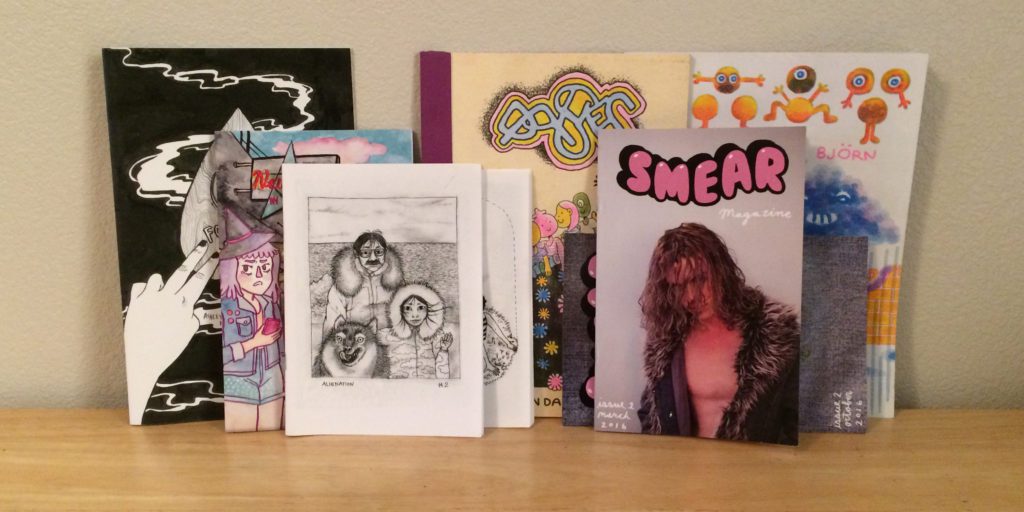This past November, I was lucky enough to table at two small press festivals in just one week, thus leaving the rest of my month free to wish I was attending more small press festivals. While that didn’t happen, I did buy and barter for enough minicomics and zines to last me the rest of the winter. And now, I’d like to share some of my favorites with you. (Sidebar: if you make zines, trade them with other creators; It’s a fun way to meet people and it lets you read a lot of cool stuff for cheap!)
The first of the two was the Short Run Comix and Arts Festival, held for its sixth year up in Seattle, Washington. On a rainy Saturday perfect for book-browsing, I sat and sold zines in a convention hall right beneath the iconic Space Needle. Watching crowds duck in and out of the drizzle to walk the aisles of hopeful young vendors and seasoned comics veterans, I was filled with optimism about my favorite hobby. Independent publishing events can be sort of insular, but Short Run felt alive and connected to the rest of the city. Plus the comics there were great.
Daisies & Sketchbook 2015-2016 – Björn Daniel Miner

Daisies is the newest, and most vibrantly colored, batch of comics by Seattle-based cartoonist Bjorn Miner. He’s been toying with this same cast of characters for a while now (previously under the name Swampson) but it’s in this issue that the individuals finally started to stand out to me. Lubis and Gus are the main two, a pair of goofball best friends with distinctively shaped heads and a penchant for mischief. Also featured is Kat, Lubis’s sister and a perpetual grump whose contrasting personality provides most of the book’s narrative thrust.

But story isn’t what draws me to these comics. The trio’s misadventures take a backseat, for me, to Miner’s artwork, especially his increasingly bold use of multi-layer risograph printing. In fact, I enjoyed his sketchbook zine about as much as his actual comics. Between the bright colors, smiling cartoon faces and generously filled backgrounds, Miner’s illustrations, unrestrained by narrative, capture a whimsy and cheerfulness that his comics sometimes miss the mark on. Either way, it’s great to see someone so sincerely exploring the possibilities of a medium that’s become saturated in the scene. This is probably my favorite riso work next to John Pham, and that’s saying something.
Daisies can be purchased here and more work can be found on the rest of Miner’s website.
Alienation #1 & #2 – Ines Estrada
Dystopian fiction can be bleak, but sometimes it comes with a trade-off. The world has gone to hell (or is at least being fitted for a handbasket), but you, the reader/viewer/player, get to experience it through a protagonist who is all the braver, more gifted and more admirable for their ability to thrive in the hellscape. The hackers in cyberpunk stories are great examples of this. In harsh, mechanized futures, their ability to traverse digital space and control objects at a distance might as well be magic. They provide a vision of humanity adapting to a rapidly changing environment, rather than being crushed by it.
Little such comfort can be found in the first two issues of Estrada’s near-future series Alienation. Her protagonists are just a normal young couple, a nameless woman and man with shitty jobs and a barren apartment. The woman performs erotic camshows for anonymous customers, while the man works on one of the last human-run oil refineries. Their off-time seems to be spent entirely indoors, on the internet, trying to escape a world which they’ve long accepted they can’t change. They struggle enough to earn rent, stave off boredom and maintain the blasé attitude which allows them to continue.
And this appears to be struggle enough. We are not given a comprehensive explanation of how their world differs from ours (or even how far in the future it is), but glimpses of the outside world and exposition dropped in offhand comments paint a sad picture. We know the couple lives in the now-congested metropolis of Ambler, Alaska, where the sky is too polluted to see a lunar eclipse. We know that all their food is “100% Glycomycota” made from “different kinds of fungus”. We know the man was in a wa We also know that the internet is now accessed via voice command and manifests as an augmented reality. This provides the most striking imagery of the comic, when the stark walls of the couple’s apartment are contrasted with Estrada’s lovingly rendered pencil drawings of nature: swirling clouds, lush vegetation and extinct wildlife.
Of course, there are hints, too, of something more mysterious happening. The woman’s bank account is hacked anonymously but none of her money seems to be missing. Her grandfather tells her that a whale has swum two hours inland, fulfilling an Iñupiat prophecy. During a nap, she is visited by a terrifying spirit that invades her body. It’s too early in the story to tell whether or not this is fate intervening to lift her out of the trap of her existence and push her into becoming the sort of dystopian hero mentioned above. But either way, her reaction is the same as to about everything else: “Sure! Fuck it! Fuck everything. Let’s go swimming!”
The next page shows the woman and her boyfriend floating in a beautiful cave pool, surrounded by jungle. But of course, we know they’re still just sitting in that blank room.
Gatosaurio, Estrada’s website, seems to be closed for the holidays but Alienation and other comics should be purchasable there in our hopefully less dystopic future.
I returned from Seattle later that week just in time to catch Press Fest Austin, a new event hosted by zine collective Free Rent ATX at the Urban Co-Lab on 12th and Chicon. The size difference alone made this a very different festival from Short Run and served as a reminder that, despite its growth, Austin is still underserved in terms of small press events. But it was a nice day and the beer was free, so I couldn’t complain too much.
SMEAR Magazine #1 & #2 – Edited by Emily Gibson & Mary Cantrell
I don’t usually review non-comics material here, but I felt compelled to write a little about this grab bag zine put out by UT students. Maybe it’s nostalgia for my own days at UT or maybe it’s their endearingly modest tagline (“Kind of a joke… but not if you like it”) or it might just be that they did a good job. Anyway, I like it. Each issue of SMEAR is short but well-designed and, importantly, none of the articles feel like padding. The focus is mostly on creative types and their relationship to the city of Austin. There are interviews with artists and musicians (including cartoonist Tillie Walden!), as well as features on the state of the local music scene and city council member Kathie Tovo (s/o District 9). None of it is particularly in-depth or hard-hitting journalism but, keeping in mind the short lengths of the features, they’re good introductions to a city full of gems worth uncovering.
Similar content, if not the printed issues listed above, can be found at smearmagazine.com.
The New Witch In Town & Follow You Into The Dark – Ashley Robin Franklin
(Disclaimer: Franklin has worked as a paid contributor for this site, but that did not influence the writing of this review.)
Like many in her generation of cartoonists, Franklin infuses her stories about contemporary life with elements of fantasy. And her particular flavor of fantastic infusion, a cute occultism featuring urban witches and ouija boards, should be familiar to readers of this site. So, when I saw she had two comics for sale at her table at Press Fest, I picked up both. The New Witch in Town is about a twentysomething’s struggle to integrate into a city (s/o to fantasy Austin!) by finding a new coven after a move with her girlfriend. Follow You Into The Dark (Franklin’s first printed work) is heavier in tone, exploring loss and grief through a teenager performing a seance.
In both comics, the prominence of these fantasy elements is somewhat misleading. Celeste the witch doesn’t perform any magic to find her new social circle; she uses the internet, just as many of us would. And talking to the dead, as Layla does in Follow… , is something many of us do regardless of whether we actually believe there are ghosts who might hear us. The fantasy then, does two things: in accepting fictionality, Franklin is free to zest her stories (Celeste isn’t a real person either way, so isn’t it more fun if she’s a witch?) but also, in exploiting fictionality, Franklin is able to more directly express the way we feel about our friends (magic when alive, painfully lingering when gone). These are early works, from a newer cartoonist, but Franklin already seems to have a firm idea of the stories she would like to tell. I hope she finds the time to tell them.
You can read The New Witch online at Franklin’s site and buy comics and pins over here.

